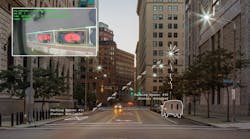Pulsed LEDs can be utilized with the time-of-flight light principle to enable object detection and ranging applications without range limitations or the inconvenience of false positives, writes MICHAEL POULIN.
The evolution of high-efficacy LED technology and beam-forming optics holds the promise to expand the fields of ranging and object detection applications. Indeed, LEDs and sensors have the potential to enable rugged and accurate ranging systems with long-range capability and even the ability to detect multiple objects. The pulsed-LED technique is inherently safe for human eyes and delivers numerous benefits relative to legacy technologies including radar and lasers.
Over the last 25 years, there haven’t been many major innovations in ranging technology, especially in the sensing side of the applications. Most of the advancements have focused on applications or on the optimization of existing technologies. In this article, we will describe a new methodology for sensing pulsed light from LEDs that solves some existing issues such as range limitations or false positives. The technique called LEDDAR (light-emitting diode detection and ranging) is based on time-of-flight (ToF) principles implemented in digital signal-processing (DSP) algorithms that process the collected backscatter of reflected light.
First, let's discuss the numerous detection and ranging methods that are currently available. The most widely used technologies include radar, laser scanners, photoelectric sensors, and ultrasonic technologies.
Each of the legacy options presents strengths and weaknesses. For instance, radar has excellent range, but it can be affected by false echoes and its refresh rate is not optimal. Laser scanners use a collimated beam to measure distance, which avoids false echoes, but they can be expensive, complex, and fragile. Ultrasonic sensors are relatively low-cost, but they are limited in range and can be affected by elements like dust. Photoelectric sensors are rugged, fast, and cheap, but their detection range is also quite limited.
The fact is that the application field could be expanded with the development of sensing capability that offers both accuracy and range, and that can be implemented in a cost-effective and reliable manner. LED-based technology offers that potential. LEDDAR performs well on the widest range of criteria when compared to other technologies.
As mentioned earlier, the innovative LED-based approach is based on the ToF of light principle, and uses light in the infrared spectrum for detection and ranging. The attributes of this novel technology enable it to not only outperform traditional approaches, but they also make it the most adaptable and accessible solution available, allowing it to cater to countless applications.
Sensing applications
The industries that LEDDAR technology can serve include agriculture, traffic management, mobile storage, industrial safety, security and surveillance, construction, defense and aerospace, robotics, automation, and even underwater applications. Examples of specific applications include:
- Optical barriers
- Smart parking
- Level sensing
- Crane operations
- Collision avoidance sensing for larger vehicles
- Loading-dock vehicle position sensing
- Truck classification sensing for inspection stations
- Vehicle detection for barrier gate control
These are just a few of the areas in which the technology has been deployed so far, but there are a wide range of possibilities. Since the technology comes in many forms, it can be adapted in so many ways that it can be integrated into a variety of different systems.
Value proposition
The advantage of LEDDAR technology is simply explained in terms of how the technique is applied. Contrary to collimated emitters such as lasers, the LEDDAR sensor's LEDs and emitter optics are used to create a diffused beam covering a wide area of interest. The multi-element receiver collects the backscatter of the reflected light from objects in the beam and, using full-waveform analysis, detects the presence of objects in each segment of the beam.
The system measures the distance of the detected objects based on the time taken by the light to return to the sensor. Accumulation and oversampling techniques are used to maximize range, accuracy, and precision. A wide range of optics options are available for the sensor modules, providing a variety of beam patterns that can be specific to the application at hand.
This unique sensing technology presents multiple advantages. The use of a diffused light beam results in increased robustness of detection on specular surfaces and in harsh weather conditions such as rain or snow. Aligning the sensor is also easier, which results in fast and simple installation. Additionally, the multi-element receiver provides detection and ranging for multiple segments of the beam without any moving parts. This makes for a more compact, reliable, and rugged assembly, all of which translate to an extended service life.
Time-of-flight principle
LEDDAR sensors use LEDs to generate very short light pulses, typically 100,000 pulses per second. The ToF principle essentially consists of measuring the time taken by a light pulse to travel from the sensor to a remote object and to return to the sensor. The range R of the detected object is deduced from the measured full round-trip time T of the light pulse using the simple relation R = c T / 2 n, where c is the speed of light in vacuum and n denotes the refractive index of the medium in which the light pulse propagates.
Depending on the characteristics of the target's surface, the light pulse is either absorbed, totally reflected, or reflected diffusely. This causes different irradiances of the echo pulse at the receiver, which are measured by the LEDDAR sensor. This measured irradiance depends on the distance measured by the ToF principle and the angle of incidence that can be determined by imaging-collecting optics that focus the reflected beam on the sensor's photodetectors. A 16-element photodetector is typically used in LEDDAR sensors (Fig. 1).
Beam pattern
The multiple-element photodetector has a rectangular sensing area. The purpose of the emission optics of a LEDDAR sensor is to direct as much of the emitted light from one or more LEDs into a pattern that best fits the photodetector geometry. The purpose of the reception optics is to collect the backscatter of light from objects in that beam onto the photodetector.
The combined emission and reception optics solution can be designed to obtain different beam widths. LeddarTech, for example, currently offers optics options with beam widths of approximately 9°, 18°, 24°, 34°, 45°, and 95°. Fig. 2 illustrates a simulated emission beam pattern of a LEDDAR sensor with an overlay of the matching segments provided by the reception optics corresponding to the photodetector elements.
How it works
The LED-based ranging technology is simple in principle but complex in implementation. As mentioned, the LED source is pulsed at a rate of approximately 100,000 pulses per second. The light pulses propagate through the detection area and reflected light is captured by the optics and the 16-element photodetector. The system must amplify the received signal and synchronize the signal to the pulses.
An oversampling scheme using multiple light pulses is implemented to improve the resolution of the acquired signal. Typical oversampling values are 4 or 8, which produce a digitized signal with an increased number of samples for improved accuracy and precision. In addition to oversampling, an accumulation process is accomplished in order to improve the signal-to-noise ratio. The oversampling value and number of accumulations influence the fidelity in terms of the detection/measurement, the range, and accuracy and precision of the measurements. The performance of the sensor can thus be optimized with these parameters to meet the requirements of a specific application.
Detection and distance measurement
The detection and distance measurement is performed by the sensor's processor, using the acquired signals — one per photodetector element. The signals consist of a series of values representing light amplitude at incremental distances from the sensor. The number of samples in the signal is chosen according to maximum range required.
The amplitude of each sample is an indicator of the quantity of light reflected back from a given object at that specific distance. The amplitude depends on distance, size, reflectivity, and angle of the object with respect to the sensor.
An object will be detected by the sensor if a light pulse above a predetermined threshold is found. The threshold at which a peak in the trace is interpreted as the presence of an object depends on the signal-to-noise ratio. LeddarTech sensors determine the default threshold level for each sensor based on the signal-to-noise ratio. A threshold table is applied in the detection processing of the traces, and a threshold offset parameter is provided on most sensors in order to adjust this threshold table. The offset can be set to increase or decrease the sensitivity of the sensor. This can be used to ignore the presence of objects returning weak signals or to maximize detection of such objects and filter false detections in the application software.
Another setting available on LeddarTech sensors is the LED intensity. LED intensity control can be set to manual mode or automatic mode. In manual control mode, the setting is adjusted by the operator to best fit the application. In automatic control mode, the sensor will dynamically adjust the LED intensity based on the amplitude of the signal for objects detected in the sensor beam. With this control, a sensor model can be used for a wide range of applications with different range requirements and also be used in applications where objects can both be very close or far from the sensor.
Fig. 3 illustrates a typical trace signal for one segment. In this example, the sensor is collecting light reflected back by two separate objects. Full waveform analysis performed by LEDDAR sensors can provide the capacity to detect multiple objects in the same segment. This capability is possible if the closer object is smaller than the illuminated area for that segment. The beam can then illuminate another object that isn't completely shadowed by the closer object.
LEDDAR benefits
When compared to other detection technologies such as laser scanners, radar, video, thermal imaging, ultrasonic, and passive infrared, LEDDAR excels on the widest range of performance criteria due to its ruggedness, 16 independent segments, simultaneous acquisition capabilities, and rapid data acquisition. Optimized for detection and ranging in 0–50m (165-ft) environments, LEDDAR can efficiently serve multiple industries, and it also offers an excellent cost/performance ratio.
In addition, this technology is available in various formats, namely assembled components, OEM modules, or application-specific sensors. As an optoelectronic technology, it can be easily customized, and it is specially designed to be easily and rapidly integrated into various applications by developers and integrators. The benefits to developers and integrators are the technology’s cost/performance ratio, ability to detect multiple objects on every segment, long detection range with low-power LEDs, real-time object-tracking capabilities, lateral discrimination, detection capability in adverse weather conditions, and ocular safety.
LEDDAR sensor module
Many developers will find that LEDDAR technology is most easily integrated into a system using a modular product. The module option, because of its compact size and flexible interfaces, can be integrated into any detection and ranging system, enabling brand owners, OEMs, and developers/integrators to use this advanced method in their own products.
LedddarTech, for instance, offers a module that is easily mounted from the back with six machine screws. The module includes an 8-pin male header connector and a simple cable harness; it can carry data using a choice of an RS-485 serial interface or the CAN bus. An expansion header with UART link is also available. Both the RS-485 and UART links implement MODBUS for configuration and data acquisition. For application-specific expansion capabilities in a system design, a Mini-B USB connector is supplied for use with a special software development kit.
As for the receiver, developers can choose from several beam options, ranging from 9° to 95°. For applications that do not require the lateral discrimination provided by the 16-element photodetector, LEDDAR technology can be implemented in a low-cost manner with a single-element beam. LeddarTech is planning to offer such a product in modular form with a 3° beam option. Such a sensor would be ideal for applications such as level sensing, proximity detection, and similar uses where a smaller form factor, robust and rugged design, excellent range, and energy efficiency are requisites.
LEDDAR sensing technology can greatly change the way detection and ranging capabilities are integrated in a wide range of industries and applications. Not only can it make these functions more accurate, reliable, and robust, but it can also make the entire solution more cost-effective. To encourage brand owners, OEMs, and developers/integrators to see how well the technology works and how easy it is to integrate, a low-cost evaluation kit is readily available for trial purposes.
MICHAEL POULINis director of product development at LeddarTech.
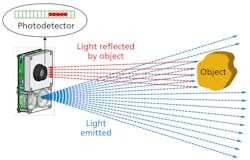
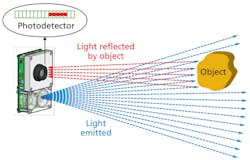

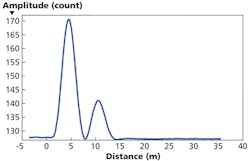
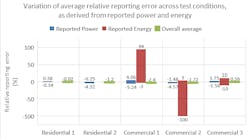
![An installer uses a cell phone to configure a connected lighting system in a Next Generation Lighting Systems (NGLS) living lab. [Photo credit: Image courtesy of Pacific Northwest National Laboratory (PNNL) and NGLS.] An installer uses a cell phone to configure a connected lighting system in a Next Generation Lighting Systems (NGLS) living lab. [Photo credit: Image courtesy of Pacific Northwest National Laboratory (PNNL) and NGLS.]](https://img.ledsmagazine.com/files/base/ebm/leds/image/2020/06/NGLS_Photo_2.5ed693de53fa2.png?auto=format,compress&fit=crop&q=45&h=139&height=139&w=250&width=250)
